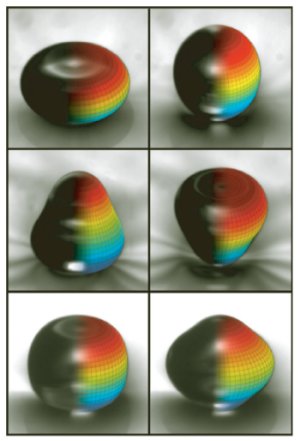
High-speed photos of actual dancing droplets (grey left half of objects) along with the mathematical description of the normal modes (coloured right half of objects).
By Hamish Johnston
There’s a paper in the New Journal of Physics today about how to make droplets of oil “dance” on the surface of a vibrating bath.
As well as floating over the surface, the droplets also seem to deform periodically in a number of distinct normal modes. In my favourite example, a droplet literally goes pear-shaped before wobbling back to something resembling a doughnut.
The research suggests that it may be easier than previously thought to levitate tiny amounts of liquid.
You might be wondering why it is important to levitate droplets? Well, it could be used to manipulate tiny amounts of liquid without actually touching it — something that could be useful in chemical or biological analysis techniques that are very sensitive to contamination.
Movies of real-life droplets as well as computer simulations can be seen here. WARNING: Their lava-lamp-like oscillations can mesmerize!



